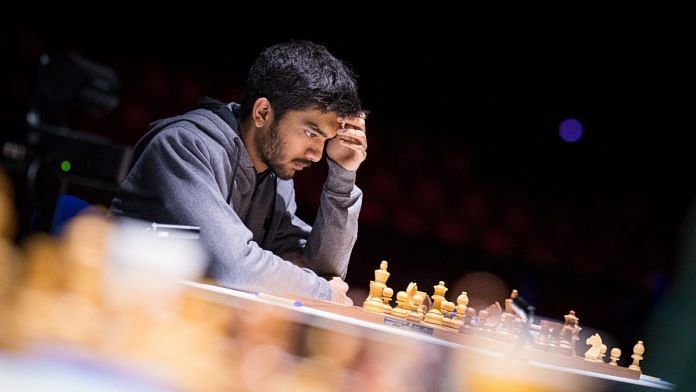Thank you dear subscribers, we are overwhelmed with your response.
Your Turn is a unique section from ThePrint featuring points of view from its subscribers. If you are a subscriber, have a point of view, please send it to us. If not, do subscribe here: https://theprint.in/subscribe/
It is an exciting time for Indians to follow the world of chess. Three young Indian players are shining bright, and many others are showcasing great potential.
Gukesh – The 18-year-old Gukesh Dommaraju became the youngest ever to qualify and win a world chess championship match. He has shattered Garry Kasparov’s record, who first became World Champion at 22 years of age. This is no small feat. Garry Kasparov is regarded as one of the greatest of all time, who came to rise during the glory days of Soviet chess.
Arjun- Known for his aggressive gameplay, the 21-year-old Arjun Erigaisi recently crossed the 2800 ELO rating, becoming only the second Indian after Vishwanathan Anand to do so. Arjun is currently the highest-rated Indian chess player.
Prag – The 19-year-old Rameshbabu Praggnanandhaa performed remarkably in the 2023 Chess World Cup, becoming the youngest-ever player to reach the final. He was bested only by the current number-one-ranked player, Magnus Carlsen.
So how did India suddenly emerge as a chess powerhouse? A lot of the credit goes to the legendary Vishwanathan Anand.
In chess, like in any other sport, access to training resources, early exposure to the game and a strong competitive environment are essential elements for young talents to emerge. As India grew economically, these essential elements became increasingly available, and India fostered talented players. However, Anand observed that despite Indians consistently reaching the top 200, not many were able to break through into the top 100. Anand, inspired by Soviet-styled chess schools, started a chess academy in partnership with Westbridge Capital. The Westbridge Anand Chess Academy (WACA) takes in youngsters who become Grandmasters before the age of 14, with the intention of turning them into world beaters. It is fitting that FIDE called Anand as the ‘Father of Indian Chess Boom’. In fact, Anand himself has expressed surprise at the results of his initiative. Quick results & multiple Indian chess players reaching the top level have exceeded Anand’s expectations.
With India’s rising chess prowess, it was inevitable that Indians would start to dominate global tournaments and fight for the most revered chess titles. The performance of the Indian contingent at the Chess Olympiad 2024, drew parallels to the peak of Soviet dominance in chess tournaments. India won the gold medal at the 2024 Chess Olympiad in the
open section, as well as the women’s section.
The World Chess Champion 2024 match has been the most interesting to follow for Indians. The key trend in this match was that the incumbent World Champion Ding Liren was happy to go into a tie-break, by drawing the 14 classical games. Ding would have considered himself as a favorite in the shorter format, given his experience and past achievements.
Gukesh was the one taking risks to create winning chances in order to overcome Ding’s defensive strategy. Hence, Gukesh’s games with white pieces, where he had the first move, were generally more exciting to watch. Overall, the match of 14 games was a close one. Gukesh, slightly nervous in his first game made a mistake despite getting into a better position after the opening. Gukesh at the end of the match mentioned that overcoming this loss was his greatest challenge in the match.
In game 3, Gukesh again with white, got an interesting position and forced Ding to spend time on every move. Eventually Ding ran out of time and Gukesh equalized the match score.This was followed by 7 draws, where Ding showcased great defensive skill. Eventually, Gukesh managed to win the 11th game with white. However, in the 12th game, where Ding had nothing to lose, he fought back with near perfect play to win the game and equalize the match score.
The 13th game was a draw, despite Gukesh gaining a good advantage at certain points. In the 14th game Ding had white pieces and he surprised everyone with a slight aggressive opening. He even got into a better position from where he should have either drawn or won the game. In a series of inexplicable decisions by Ding, it was Gukesh who got into a position from which he could not lose the game. Eventually when it looked like the match was going into a tie-break, the incumbent World Champion made a blunder, losing the game and the World Championship title. While Gukesh started the match as the favorite, the manner in which he won the last game was rather anticlimactic.
Now, we have a World Champion who wants his reign to be long and compete with the best players, be it Magnus Carlsen or any other emerging Indian player. It may well be the case that the two Indians end up competing in the next World Chess Championship Match.
These pieces are being published as they have been received – they have not been edited/fact-checked by ThePrint


